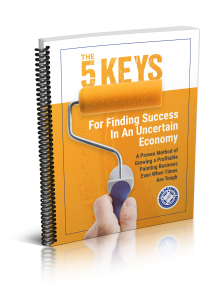How to Reduce Painting Business Stress in Four Simple Steps
Stress. Anxiety. Worry. Overwhelm.
They are ALL part of owning a painting business – on occasion.
But, they should not be the NORM for anyone. In this article, I’m going to walk you through a very powerful exercise that help can relieve tons of stress and worry.
And no: This exercise isn’t doing “12 ounce curls.” It’s something you can do DURING business hours.
As I talk with painters every day, many of them are anxious and frustrated.
Contractors considering joining the APPC are frustrated because they don’t know what to do and haven’t achieved the level of success they know is possible. They struggle with a lack of knowledge, resources, and guidance.
Conversely, once painting contractors join the APPC and have the all tools they need to succeed, thorough implementation becomes the new goal. Knowledge and resources, once discovered, presents thier own set of personal challenges.
Regardless of their level of success or marketing knowledge, I have noticed one glaring mistakes that most painting contractors are making. This mistake causes undue stress, mental fatigue, and in some cases “paralyzes the brain.”
Here it is: Owners are keeping EVERYTHING or least the vast majority of it, in their HEADS!
I’m not talking about just the “owner operators” here. I’m talking about the “$1,000,000 Plus Club” too. Lest you think, as we are ALL prone to do, that “This doesn’t apply to me…”
So, if your brain is frazzled… If you feel despondent and overwhelmed with your painting business, let me give you a few simple, easy methods you can use to clear up the “log jam” in your mind.
This is NOT a comprehensive process, such as the one written out in the APPC Marketing Mastery Module: Marketing Implementation Secrets – A Painting Fortune in Four Hours Per Week. However, it likely more helpful than what you’re doing now.
Step One: Get it ALL On Paper and OUT of Your HEAD!
You see, your brain is like a computer. It has its own RAM (operating capacity.) Your mental RAM is needed to make decisions, organize priorities, and solve problems. If your RAM is choked with a thousand “to-dos,” worries, and problems, it cannot function as intended.
In fact, your mind can only store about seven priority pieces of information before it begins to generate unnecessary stress for you. Your mind will start “reminding” you about things that you can’t do ANYTHING about at the moment.
Why does your mind do that? Simply put, it doesn’t trust you to remember everything because you haven’t developed a “reliable” place to store all of this important information. So, the only solution is knows to this “problem” is to constantly interrupt your thinking and “serve up” all the problems you’re NOT addressing at this very moment.
In this way, your smart brain is very “dumb.” To short-circuit this and stop it from happening, you need a place to store this information. I like the good, old-fashioned legal pad.
Here’s what you need to write down in no discernible order and without organization of any kind. Just write It down as it comes to you – hold noting back…
*Problems you have or situations that are worrying you
*Things to do in any category – this can be related to home, work, or otherwise
*Projects you feel you need to complete or start
*Things you might want to do one day
*Really, anything that comes to mind. Just write it down.
Once you complete this exercise, you may have two pages or twenty-two pages. It doesn’t matter.
What you will discover, immediately, is that the act of doing this makes you feel better. You have now given your mind permission to relax. You have told your subconscious mind, “See, all that stuff you keep reminding me about is stored on these pages. You don’t have to make me anxious by constantly reminding me of it.”
Step Two: Organize the “Stuff” Into Categories That Make Sense for You
These categories may consist of “work,” “home,” “health,” “family,” or any other way you wish to arrange them. Sometimes, if you are up against a deadline and pressed to achieve a certain outcome, you may wish to segment these by timelines such as “to do today,” “finish before vacation,” or “15-day revenue generation project.”
It’s really up to you. But, by all means, organize them.
Step Three: Turn Projects Into Actionable Items
One of the biggest reasons people “get stuck” on a project is because they have not thought it all the through to discrete, actionable items. As an example, you might have “Approach ABC Manufacturing for Maintenance Repaint Work” on your to-do list as a project.
However, in reality, you can’t physically do that. What you really need to ask yourself is this question: “What is the next thing I can physically do to move this project forward?” The answer in this case might be to “Call my sister’s friend Karen who works in accounts receivable to see if she can get me the contact number of a decision maker.”
Don’t have Karen’s phone number? Then your REAL next action step is to “Text my wife for Karen’s phone number.”
You may think I’m making a distinction without a difference, but I would disagree. I ask contractors all the time, “What’s the next thing you need to do to get this project moving forward?”
Very often, they don’t have the answer because they have not “thought hard” about it. They haven’t done the “tough thinking” that changes a “fuzzy to-do list” into an actionable list of items to execute.
Step Four: Pick Three and Do Them In Order
Once EVERYTHING that’s on your mind is written down, organized, and distilled into actionable items, the next source of stress and anxiety comes from the attempt we place upon ourselves to do everything at once.
Yes, you’ve made a big list there. No, you cannot do everything at once. Yes, everything on this list is very important. No, there is no value gained from “thinking about” everything you “aren’t doing” continuously.
It some point, you have to take a deep breath, calm down, and say: “I am working on these three things first. I’m working on #1 now and I will not stop until it is finished.”
In Summary
To many of you reading this, what I’ve just shared with you, if applied, could be transformative. For others, you’ll remark, “Well that’s obvious. I know that.”
But you see, it’s now in the knowing of things that things get done. It is in the doing of things that things get done.
Now, for the small monitory who says they “do this” already, I want to applaud you. You are in the small minority of minorities. Even if you are doing this in some fashion, I would challenge you to challenge yourself: How can you do it better?
Over the next few days, I want you to take notice of when you begin to feel stressed, anxious, and overwhelmed. When you do, take a deep breath, pause for a few minutes, and walk through this exercise. You may find that you are able to banish all or part of your painting worries – from now until you hang up your proverbial brush forever
Brandon Lewis, B.S., M.B.A.
Director of the Marketing Department
The Academy for Professional Painting Contractors
Department: 423-800-0520
The 5 Keys for Success in ANY Economy

Discover the key to unlocking the hidden income potential in your painting business.
Hear What Other Members are Saying:

Jim and Lorraine
“Our first campaign reached $60,041.98! That's a huge percentage of our annual sales! You don't pick the peach orchard just one time. Different peaches ripen every day. Thanks for encouraging us to keep after it!”

Eric
“15 requests for quotes and closed and/or completed $23,000 of work and I still have a few more to do. Conservatively this campaign will net $25,000 in found money in the first 45 days! Thanks Brandon!”

Torlando
“This year has been the biggest year of growth for us. We're double where we were last year. I realized the real money in this business is in the marketing of the services - not the doing of the services.”
The 5 Keys for Success in ANY Economy
Discover the key to unlocking the hidden income potential in your painting business.

